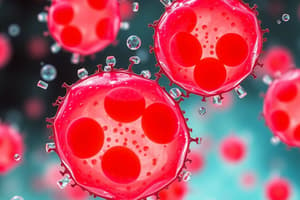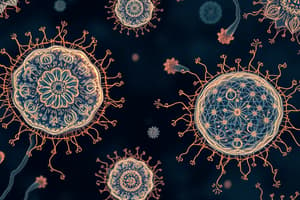Podcast
Questions and Answers
What is the basic unit of life?
What is the basic unit of life?
Cell
Which statement is true about the cell theory?
Which statement is true about the cell theory?
- Every living organism is made of two cells.
- All cells arise from preexisting cells. (correct)
- Cells do not contain genetic information.
- Cells cannot perform life functions.
Viruses are exceptions to the cell theory.
Viruses are exceptions to the cell theory.
True (A)
Cells contain cytoplasm, which is the location of ______ activity.
Cells contain cytoplasm, which is the location of ______ activity.
Match the scientist with their contribution to cell theory:
Match the scientist with their contribution to cell theory:
Who contributed to the discovery of the cell and what are their discoveries?
Who contributed to the discovery of the cell and what are their discoveries?
Explain the relationship between cell shape and cell function.
Explain the relationship between cell shape and cell function.
Briefly discuss the factors that limit cell size.
Briefly discuss the factors that limit cell size.
Compare and contrast prokaryotic cells and eukaryotic cells.
Compare and contrast prokaryotic cells and eukaryotic cells.
Give at least five examples of unicellular and multicellular organisms and briefly describe them.
Give at least five examples of unicellular and multicellular organisms and briefly describe them.
With the aid of a diagram, describe the functions of each organelle in a typical plant or animal cell.
With the aid of a diagram, describe the functions of each organelle in a typical plant or animal cell.
In a tabular form, give the differences between plant cell and animal cell.
In a tabular form, give the differences between plant cell and animal cell.
Flashcards are hidden until you start studying
Study Notes
Introduction to Computational Biology
Cell Basics
- The cell is the basic unit of life
- All living organisms are made up of one or more cells
- Cells carry out all processes of life
Cell Theory
- Every living organism is made up of one or more cells
- The cell is the basic unit of structure and function
- All cells arise from preexisting cells
Exceptions to Cell Theory
- Viruses lack protoplasm and are an exception to the cell theory
- Bacteria and cyanobacteria lack a well-organized nucleus
- Some protozoans are acellular
- Coenocytic hyphae of some fungi have undivided mass of protoplasm
- Red Blood Corpuscles (RBC) and mature sieve tubes are without nuclei
Basic Features of All Cells
- Plasma membrane encloses the cell and mediates interactions between the cell and its environment
- Cells contain cytoplasm, which is the location of metabolic activity
- Genetic information is contained in DNA
- Cells obtain energy and nutrients from the environment
- Cell function limits cell size due to diffusion and surface area to volume ratio
Cell Production
- Every cell is produced by the division of a preexisting cell
- Genetic material is passed down from one cell to another during the reproduction process
Cell Discovery
- The cell theory grew out of the work of many scientists and improvements in the microscope
- Many scientists contributed to the cell theory, including Anton van Leeuwenhoek, Robert Hooke, Mathias Schleiden, Theodor Schwann, and Rudolf Virchow
- Microscope development, including light and electron microscopes, has enabled the discovery of cells
Cell Diversity
- There are about 200 different types of cells
- Cells come in a variety of shapes and sizes
- Cellular diversity permits the organization of cells into more complex tissues and organs
- Cell shape reflects its function
- Cell size is limited by a cell's surface area to volume ratio
Cell Differentiation
- Differentiation is the process during development where newly formed cells become more specialized and distinct from one another as they mature
- All cells of an organism share an identical genome, but different genes are activated in different cells to cause differentiation
- Single-celled organisms are made up of one cell that carries out all functions
- Multicellular organisms are made up of many cells that often specialize according to function
Types of Cells
- Prokaryotic cells lack a nucleus and have naked DNA in the cytoplasm, with only ribosomes
- Eukaryotic cells have a nucleus and organelles
- Examples of prokaryotic cells include bacteria, blue-green algae, and amoeba
- Examples of eukaryotic cells include animals, plants, fungi, and protists
Plant and Animal Cells
- Plant cells have a cell wall, chloroplasts, and a large vacuole
- Animal cells lack a cell wall, have lysosomes, and a small vacuole
Organelles
- Organelles are structures within a cell that have a specific function
- Examples of organelles include the nucleus, mitochondria, ribosomes, and lysosomes
Studying That Suits You
Use AI to generate personalized quizzes and flashcards to suit your learning preferences.




